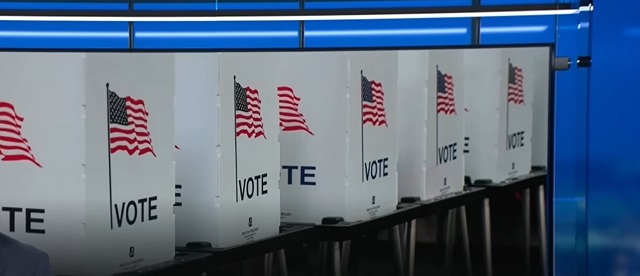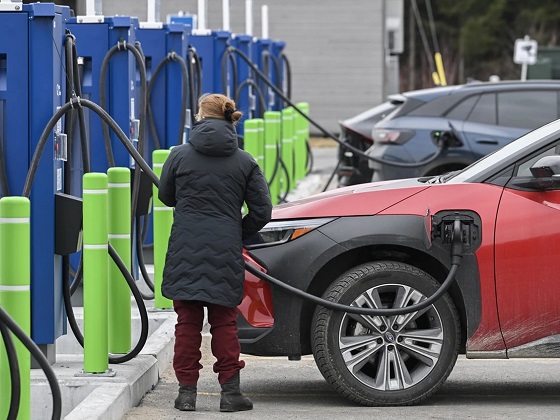Daily Caller
‘Zuck Bucks’ Need To Be Stopped Cold

 From the Daily Caller News Foundation
From the Daily Caller News Foundation
By Jason Snead
It is less than 90 days to Election Day, and right on queue the group behind the “Zuck Bucks” campaign of 2020 is back with a new scheme. This time, the Center for Tech and Civic Life (CTCL) is doling out millions in grant dollars to rural election administrators in 19 states.
Election officers beware. The group is trying to turn the government offices that run elections into bastions of partisan progressive activism. Election officials striving for nonpartisanship should steer clear.
CTCL rose to prominence during the unprecedented election of 2020. The group got $350 million from Meta CEO Mark Zuckerberg, which it then funneled disproportionately to swing-state communities that ultimately voted for Joe Biden.
Racine, Wisconsin used its CTCL money to purchase a mobile voting van that in 2022 it deployed to heavily Democrat areas of the city to register voters and collect ballots. Earlier this year, a judge declared that illegal.
After 2020, a majority of states moved to ban or restrict private funding for running election offices, including several on a bipartisan basis. This year, Wisconsin voters approved two constitutional amendments to ban private funding after the scope of CTCL’s involvement was revealed. Even Mark Zuckerberg announced he would no longer back the group’s grants.
But that did not stop CTCL. Instead, it created “Zuck Bucks 2.0,” an $80 million program called the U.S. Alliance for Election Excellence.
Now, CTCL is offering grants to rural counties, saying it is merely helping cash-strapped offices on the eve of a contentious election. Sound familiar?
The sudden interest in flyover country is laughable. In 2020, rural areas got token grants of just $5,000 while urban areas got millions. CTCL claimed that big cities have more voters and therefore need more money. Subsequent analyses showed that blue counties got far money more per voter than red counties.
Perhaps CTCL hopes this move can insulate it against criticism that it is once again influencing elections. Not so fast. Reports indicate that CTCL is setting aside $2.5 million for rural grants.
CTCL is giving $3 million to Clark County, Nevada, for this election cycle alone. Add in the huge grants offered to heavily Democrat DeKalb County, Georgia and Madison, Wisconsin, and CTCL has given nearly three times the grants to just these heavily Democrat areas (located in swing states, no less) than hundreds of rural counties could get combined.
In fairness, CTCL is not wrong that rural areas often need additional resources. But those funds should come from state and local taxpayers, not partisan groups pushing an agenda.
And make no mistake, CTCL has a political agenda. Though it claims to be nonpartisan, it’s founder and executive director is a former Obama Foundation fellow and used to work at a group the Washington Post once labeled the “Democratic party’s Hogwarts for digital wizardry.” CTCL’s donors are just as left-wing, with major liberal organizations like the Skoll Foundation, Democracy Fund, and Arabella Advisors’ New Venture Fund footing its bills.
Small wonder, then, that by this April 28 states had banned or restricted CTCL-style private funding. Over the last few years, residents in communities from Greenwich, Connecticut, to Brunswick County, North Carolina, have opposed election administrators joining ranks with such a partisan group. Ottawa County, Michigan, declined to accept $1.5 million in CTCL funds with the county clerk explaining that accepting the grant could compromise public confidence in elections.
Over the next few months, CTCL will offer hundreds of rural counties “free” money. Many may feel inclined to take it. Before they do, they should know who they are doing business with.
Rural election offices may need additional funding, but turning to partisan groups like CTCL just puts public trust in elections at risk. County officials should treat CTCL’s latest offer of “free” money the way they would treat a windowless van hanging a sign marked “free candy:”
Stay away and warn your friends.
Jason Snead is the Executive Director of Honest Elections Project Action.
Daily Caller
Trump Orders Review Of Why U.S. Childhood Vaccination Schedule Has More Shots Than Peer Countries


From the Daily Caller News Foundation
By Emily Kopp
President Donald Trump will direct his top health officials to conduct a systematic review of the childhood vaccinations schedule by reviewing those of other high-income countries and update domestic recommendations if the schedules abroad appear superior, according to a memorandum obtained by the Daily Caller News Foundation.
“In January 2025, the United States recommended vaccinating all children for 18 diseases, including COVID-19, making our country a high outlier in the number of vaccinations recommended for all children,” the memo will state. “Study is warranted to ensure that Americans are receiving the best, scientifically-supported medical advice in the world.”
Trump directs the secretary of the Health and Human Services (HHS) and the director of the Centers for Disease Control and Prevention to adopt best practices from other countries if deemed more medically sound. The memo cites the contrast between the U.S., which recommends vaccination for 18 diseases, and Denmark, which recommends vaccinations for 10 diseases; Japan, which recommends vaccinations for 14 diseases; and Germany, which recommends vaccinations for 15 diseases.
Dear Readers:
As a nonprofit, we are dependent on the generosity of our readers.
Please consider making a small donation of any amount here.
Thank you!
HHS Secretary Robert F. Kennedy Jr. has long been a critic of the U.S. childhood vaccination schedule.
The Trump Administration ended the blanket recommendation for all children to get annual COVID-19 vaccine boosters in perpetuity. Food and Drug Administration (FDA) Commissioner Marty Makary and Chief Medical Officer Vinay Prasad announced in May that the agency would not approve new COVID booster shots for children and healthy non-elderly adults without clinical trials demonstrating the benefit. On Friday, Prasad told his staff at the Center for Biologics Evaluation and Research that a review by career staff traced the deaths of 10 children to the COVID vaccine, announced new changes to vaccine regulation, and asked for “introspection.”
Trump’s memo follows a two-day meeting of vaccine advisors to the Centers for Disease Control and Prevention in which the committee adopted changes to U.S. policy on Hepatitis B vaccination that bring the country’s policy in alignment with 24 peer nations.

Total vaccines in January 2025 before the change in COVID policy. Credit: ACIP
The meeting included a presentation by FDA Center for Drug Evaluation and Research Director Tracy Beth Høeg showing the discordance between the childhood vaccination schedule in the U.S. and those of other developed nations.
“Why are we so different from other developed nations, and is it ethically and scientifically justified?” Høeg asked. “We owe our children science-based recommendations here in the United States.”
Daily Caller
Tech Mogul Gives $6 Billion To 25 Million Kids To Boost Trump Investment Accounts


From the Daily Caller News Foundation
Billionaire Michael Dell and his wife, Susan, announced Monday that they will give 25 million American children a $250 deposit as an initial boost to President Donald Trump’s new investment program for children.
The Dells’ pledge totals $6.25 billion and will be routed through the Treasury Department. The goal, they say, is to extend access to the federal Invest America program — referred to as “Trump accounts” — established by the One Big Beautiful Bill Act, signed into law by the president in July.
The federal program guarantees a $1,000 federally funded account for every child born from 2025 through 2028, but the Dells’ money will instead cover children 10 years old and younger in ZIP codes where the median household income is under $150,000, according to Bloomberg.
Dear Readers:
As a nonprofit, we are dependent on the generosity of our readers.
Please consider making a small donation of any amount here.
Thank you!
“What inspired us most was the chance to expand this opportunity to even more children,” the Dells wrote in the press release. “We believe this effort will expand opportunity, strengthen communities, and help more children take ownership of their future.” (RELATED: Trump Media Company To Create Investment Funds With Only ‘America First’ Companies)
Dell, founder and CEO of Dell Technologies with a net worth of about $148 billion, has been one of the most visible corporate leaders championing the Trump accounts. In June, he joined Goldman Sachs CEO David Solomon, Uber CEO Dara Khosrowshahi, and others at a White House roundtable promoting the initiative.
In addition to the new $6.25 billion pledge, Dell Technologies committed to matching the government’s $1,000 contribution for the children of its employees. Other companies, such as Charter Communications, Uber, and Goldman Sachs, have said they are willing to match the government’s contributions when the accounts launch.
“This is not just about what one couple or one foundation or one company can do,” the couple wrote. “It is about what becomes possible when families, employers, philanthropists, and communities all join together to create something transformative.”
Starting July 4, 2026, parents will be able to open one of the accounts and contribute up to $5,000 a year. Employers can put in $2,500 annually without it counting as taxable income.
The money must be invested in low-cost, diversified index funds, and withdrawals are restricted until the child turns 18, when the funds can be used for college, a home down payment, or starting a business. Investment gains inside the account grow tax-free, and taxes are owed only when the money is eventually withdrawn.
The accounts will “afford a generation of children the chance to experience the miracle of compounded growth and set them on a course for prosperity from the very beginning,” according to the Trump administration.
The broader effort was originally spearheaded in 2023 by venture capitalist Brad Gerstner, who launched the nonprofit behind the Invest America concept.
“Starting 2026 & forevermore, every child will directly share in the upside of America! Huge gratitude to Michael & Susan for showing us all what is possible when we come together!” Gerstner wrote on X.
-

 Business2 days ago
Business2 days agoRecent price declines don’t solve Toronto’s housing affordability crisis
-

 MAiD21 hours ago
MAiD21 hours agoFrom Exception to Routine. Why Canada’s State-Assisted Suicide Regime Demands a Human-Rights Review
-

 MAiD2 days ago
MAiD2 days agoHealth Canada report finds euthanasia now accounts for over 5% of deaths nationwide
-

 Daily Caller2 days ago
Daily Caller2 days agoTech Mogul Gives $6 Billion To 25 Million Kids To Boost Trump Investment Accounts
-

 Automotive2 days ago
Automotive2 days agoPower Struggle: Governments start quietly backing away from EV mandates
-

 Energy2 days ago
Energy2 days agoUnceded is uncertain
-

 Business19 hours ago
Business19 hours agoCarney government should privatize airports—then open airline industry to competition
-

 Business2 days ago
Business2 days agoNew Chevy ad celebrates marriage, raising children




